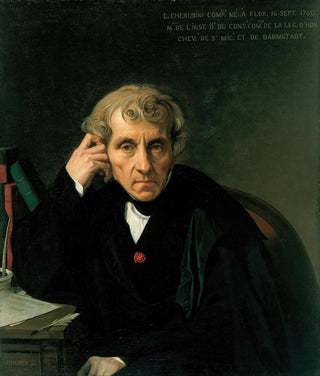Art print | Luigi Cherubini - Jean-Auguste-Dominique Ingres


View from behind

Frame (optional)
Reproduction Luigi Cherubini - Jean Auguste Dominique Ingres – Introduction captivante
The "Luigi Cherubini" art print by Jean Auguste Dominique Ingres is a masterpiece that transcends a simple portrait to become a true celebration of art and music. Created in 1811, this depiction of the Italian composer Luigi Cherubini embodies not only the painter's talent but also the spirit of an era when music and visual arts nourished each other. Ingres, with his mastery of lines and keen attention to detail, manages to capture the very essence of his subject, offering viewers a window into the intellectual and artistic world of the early 19th century. This piece, both intimate and monumental, invites an in-depth exploration of the relationships between art, music, and culture.
Style and uniqueness of the work
Ingres's style is distinguished by its rigorous classicism, precision, and meticulous attention to detail. In the "Luigi Cherubini" art print, the features of the composer are rendered with remarkable finesse, each shadow and light playing an essential role in the composition. Cherubini's face, imbued with a certain gravity, is highlighted by subtle lighting that emphasizes his contemplative, almost melancholic expression. The drapery surrounding him, carefully executed, testifies to Ingres's virtuosity and his concern for realism. This piece does not merely depict a man; it also evokes an era, an artistic movement, and a shared passion for music. The color palette chosen by the artist, both sober and elegant, helps create an atmosphere of dignity and respect for his subject.
The artist and his influence
Jean Auguste Dominique Ingres, an emblematic figure of Neoclassicism, left a mark on art history through his innovative approach and dedication to faithful representation of reality. A student of David, he developed a style that is uniquely his own, blending academic rigor with personal sensitivity. Ingres always had a fascination with portraits, considering these works as means of expressing human emotions and individual characters. His influence on subsequent generations is undeniable, inspiring artists such as Degas and Picasso

Matte finish

View from behind

Frame (optional)
Reproduction Luigi Cherubini - Jean Auguste Dominique Ingres – Introduction captivante
The "Luigi Cherubini" art print by Jean Auguste Dominique Ingres is a masterpiece that transcends a simple portrait to become a true celebration of art and music. Created in 1811, this depiction of the Italian composer Luigi Cherubini embodies not only the painter's talent but also the spirit of an era when music and visual arts nourished each other. Ingres, with his mastery of lines and keen attention to detail, manages to capture the very essence of his subject, offering viewers a window into the intellectual and artistic world of the early 19th century. This piece, both intimate and monumental, invites an in-depth exploration of the relationships between art, music, and culture.
Style and uniqueness of the work
Ingres's style is distinguished by its rigorous classicism, precision, and meticulous attention to detail. In the "Luigi Cherubini" art print, the features of the composer are rendered with remarkable finesse, each shadow and light playing an essential role in the composition. Cherubini's face, imbued with a certain gravity, is highlighted by subtle lighting that emphasizes his contemplative, almost melancholic expression. The drapery surrounding him, carefully executed, testifies to Ingres's virtuosity and his concern for realism. This piece does not merely depict a man; it also evokes an era, an artistic movement, and a shared passion for music. The color palette chosen by the artist, both sober and elegant, helps create an atmosphere of dignity and respect for his subject.
The artist and his influence
Jean Auguste Dominique Ingres, an emblematic figure of Neoclassicism, left a mark on art history through his innovative approach and dedication to faithful representation of reality. A student of David, he developed a style that is uniquely his own, blending academic rigor with personal sensitivity. Ingres always had a fascination with portraits, considering these works as means of expressing human emotions and individual characters. His influence on subsequent generations is undeniable, inspiring artists such as Degas and Picasso






